Best Historical Pictures
The Heroic Age of Antarctic Exploration
A collection of 45 selected photographs from the early days of the 20th century when the map of Antarctica had more blank areas than known areas, when there were many "firsts" waiting to be taken and when success walked alongside hardship, failure and possible death.
This is a personal selection of pictures, each of which I feel is able to stand alone as a poignant image of its time and place and also as a well executed photograph outside of these parameters. They are in no particular order, each comes with a description of context, I hope you enjoy them as much as I do.
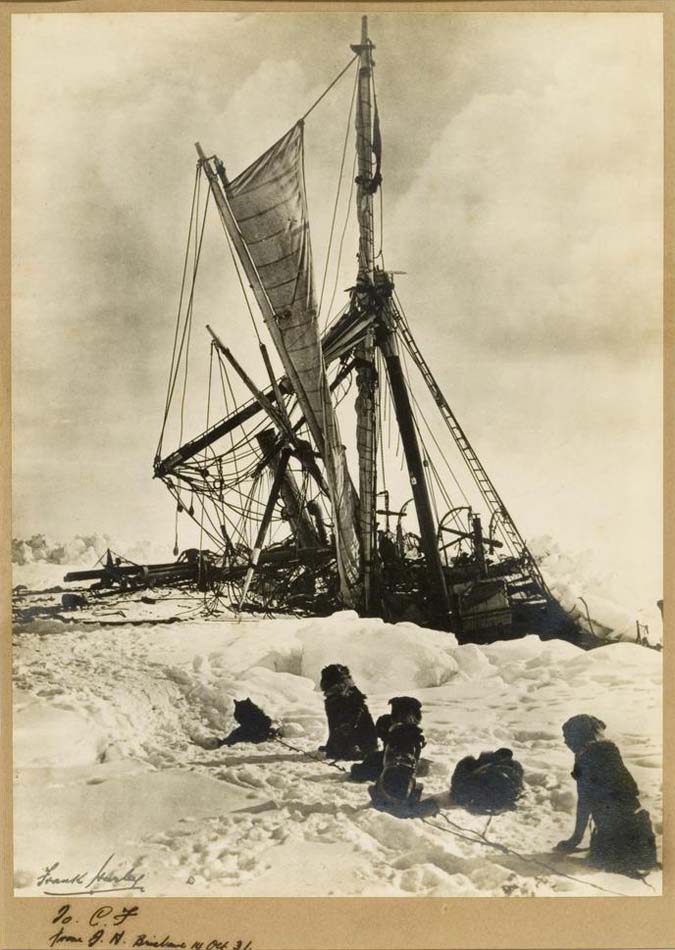
The Endurance lies crushed,
still above the ice, though shortly to sink. 28 men led
by Ernest Shackleton are left in the middle of the Weddell Sea with
no hope of rescue.
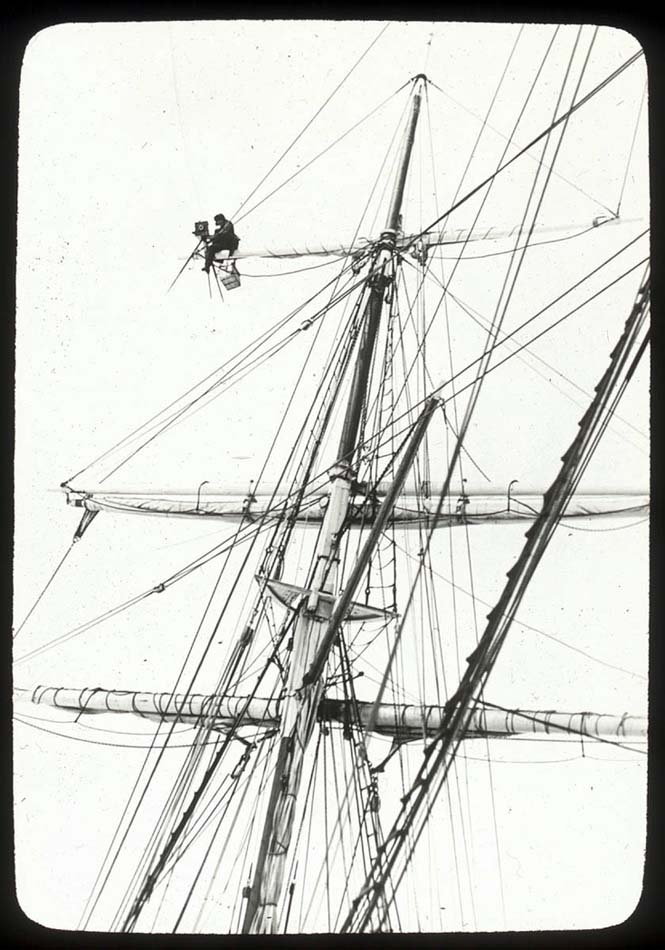
Frank Hurley high in the rigging
of the Endurance with a cine camera.
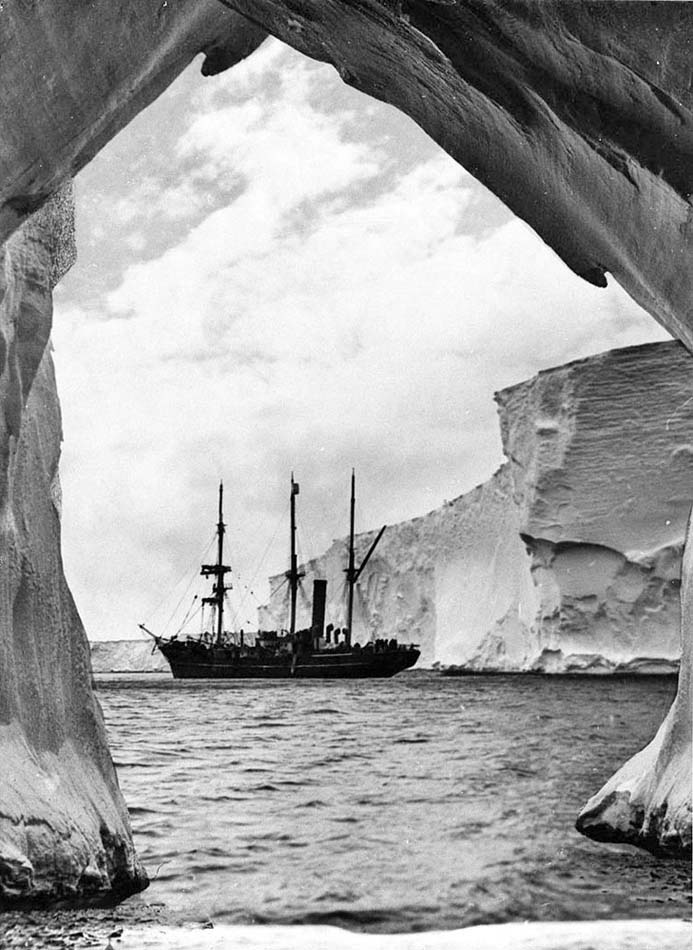
SY Aurora on Mawson's Austalian
Antarctic Expedition as seen through the arch of an ice berg.
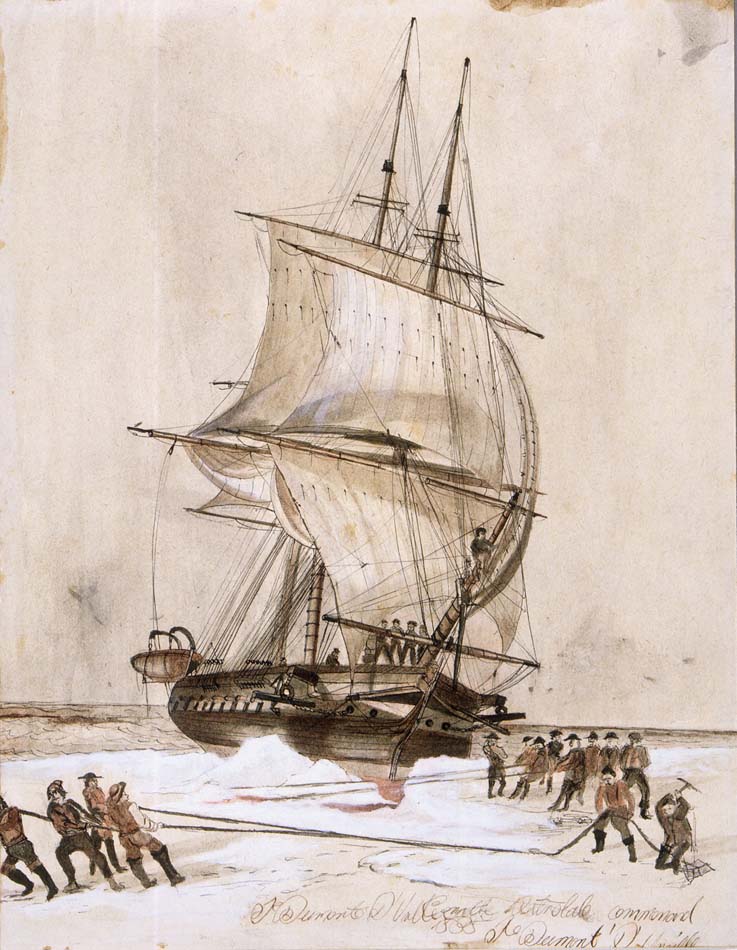
A little out of place maybe and not a photograph,
the French ship Astrolabe caught in the pack in
Antartica in 1838, no power other than sail and the muscle of the
crew.
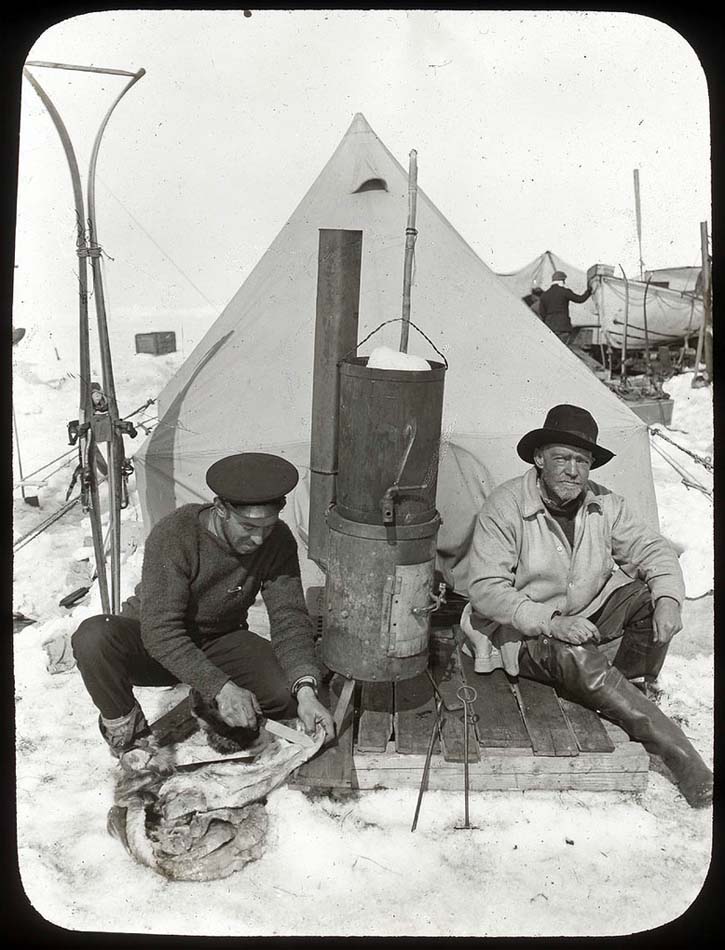
Frank Hurley (left) and Ernest Shackleton
(right) camping on the pack ice after the Endurance had
sunk, 1915.
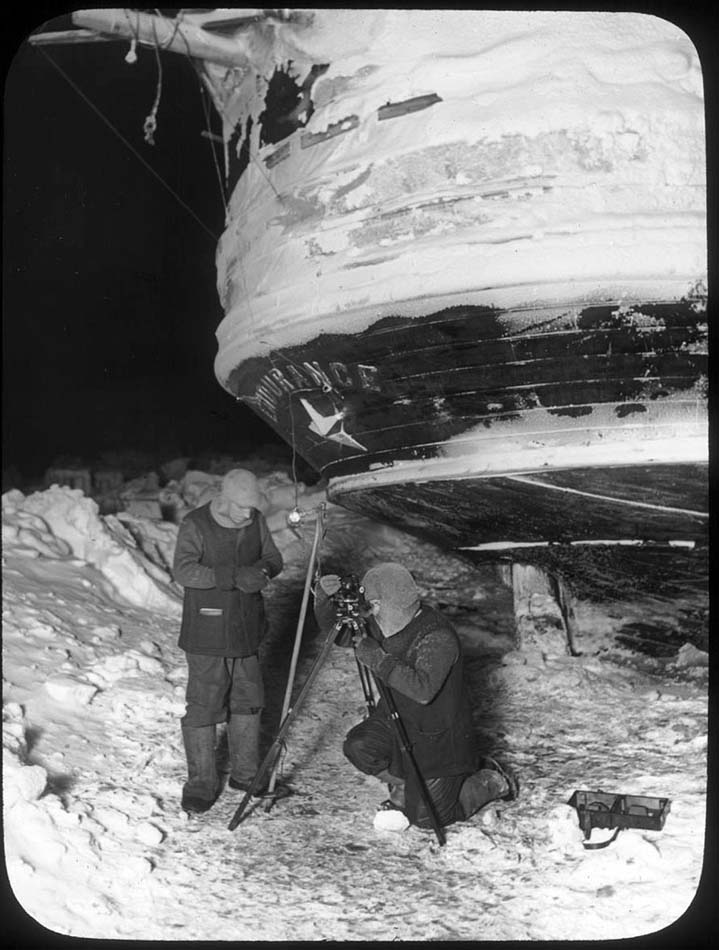
The Endurance in the winter of 1915, stuck
in the pack ice, still hoping to be released the following
spring.

The Endurance at night on the 27th
of August 1915, lit by 20 flashes set off by Frank Hurley, half
blinding himself, stumbling into snow drifts and banging his shins
in the process!
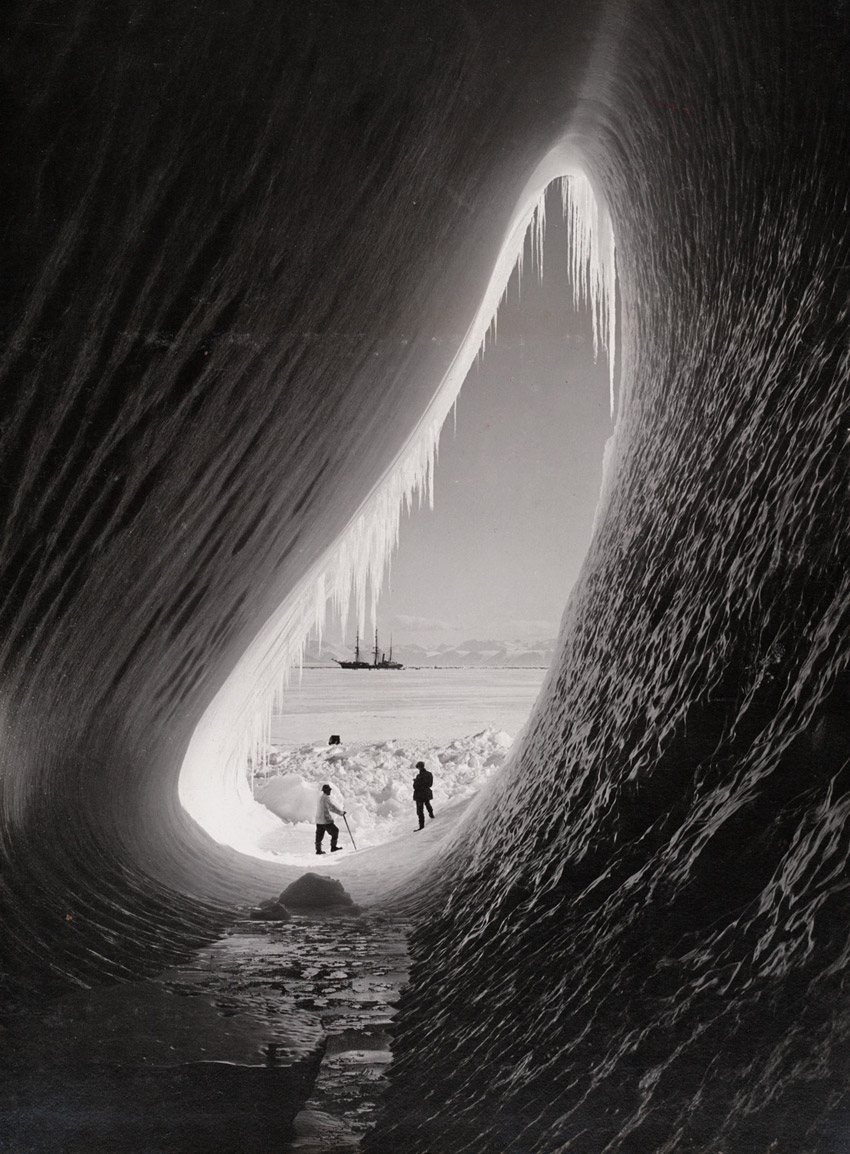
Possibly the best known picture from the Heroic Age,
Herbert Ponting's picture taken from a cave inside an
ice berg, Charles Wright and Thomas Griffith Taylor are
pictured with Scott's ship the Terra Nova in the distance.
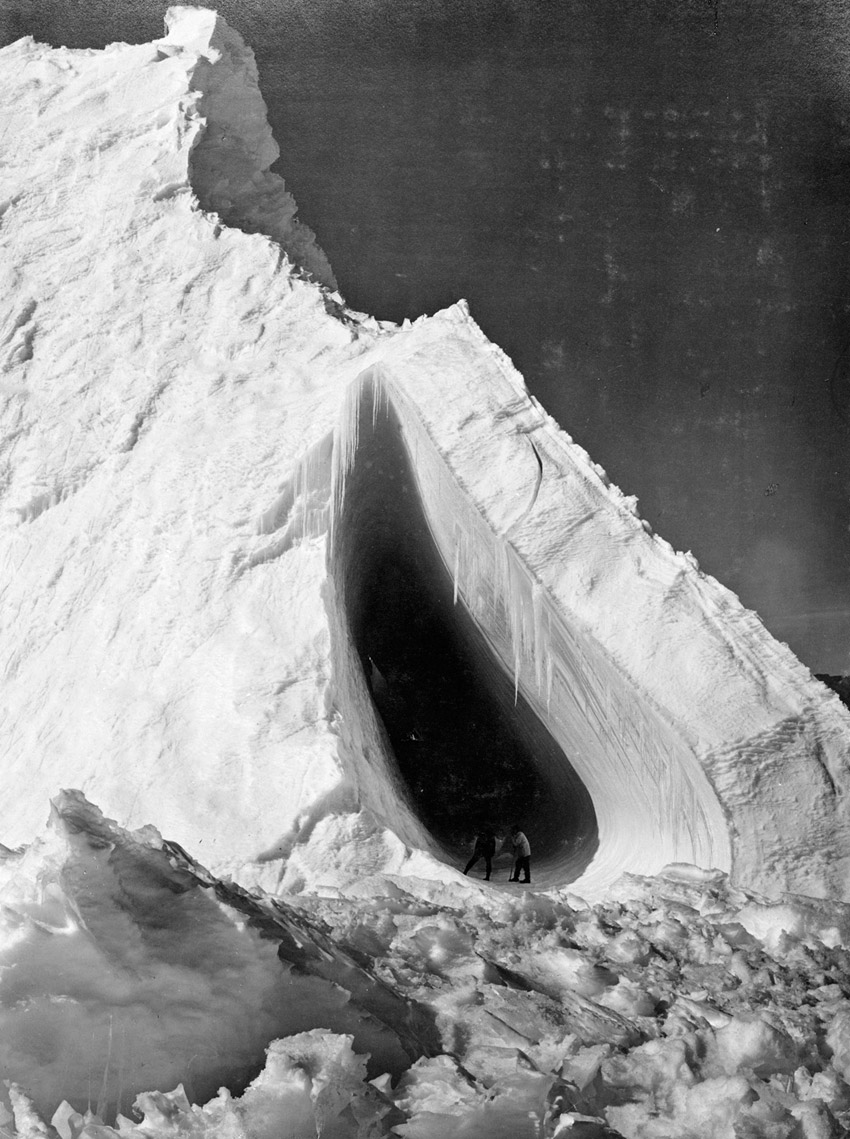
A less commonly seen picture of the ice-berg
cave taken from the outside, Ponting described the interior
of the cave as a "symphony in blue and green", unfortunately
it was before colour photography was very advanced.
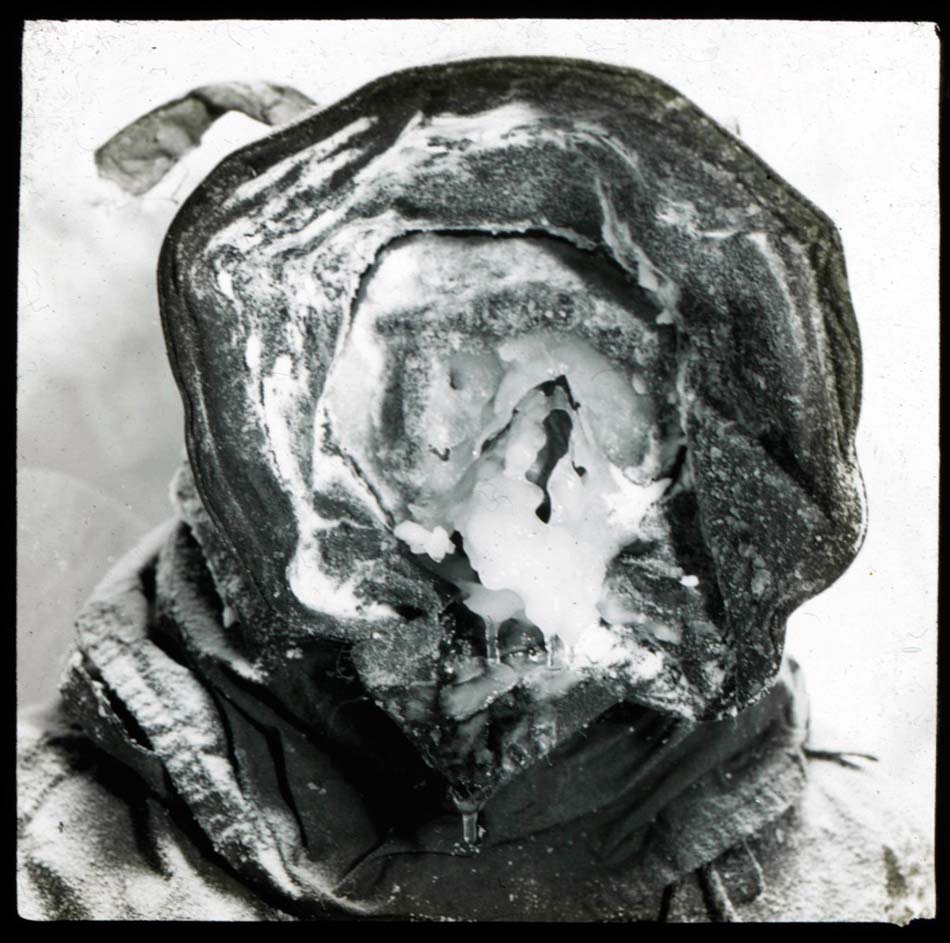
Cecil Thomas Madigan, ice mask ,the
meteorologist with Australian Douglas Mawson's expedition of
1911-14, build up caused while he was returning to the base hut
during a blizzard
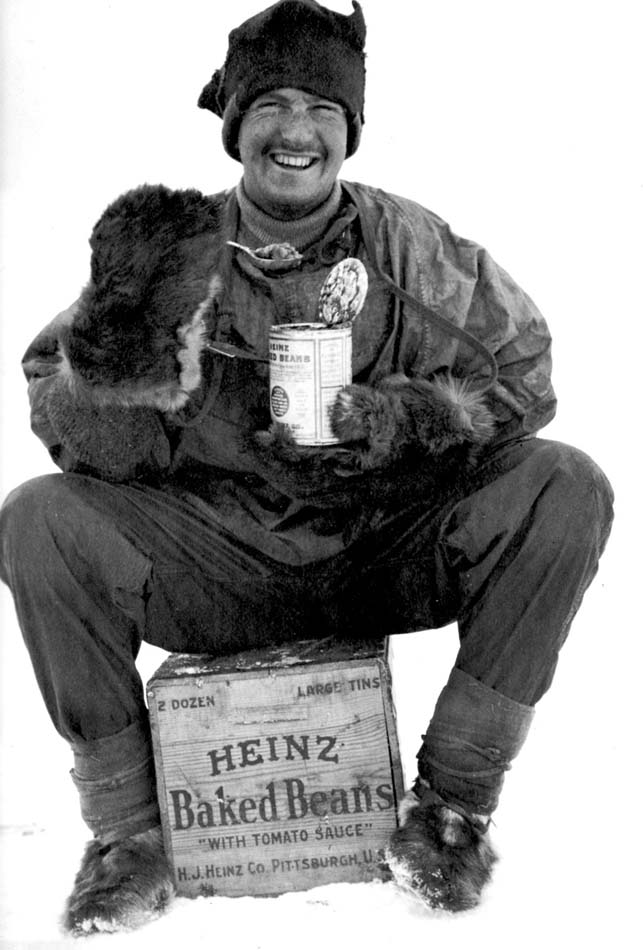
Frederick J. Hooper, steward on Scott's
expedition on the Terra Nova gets involved in some early
product placement for one of the sponsors of the expedition.
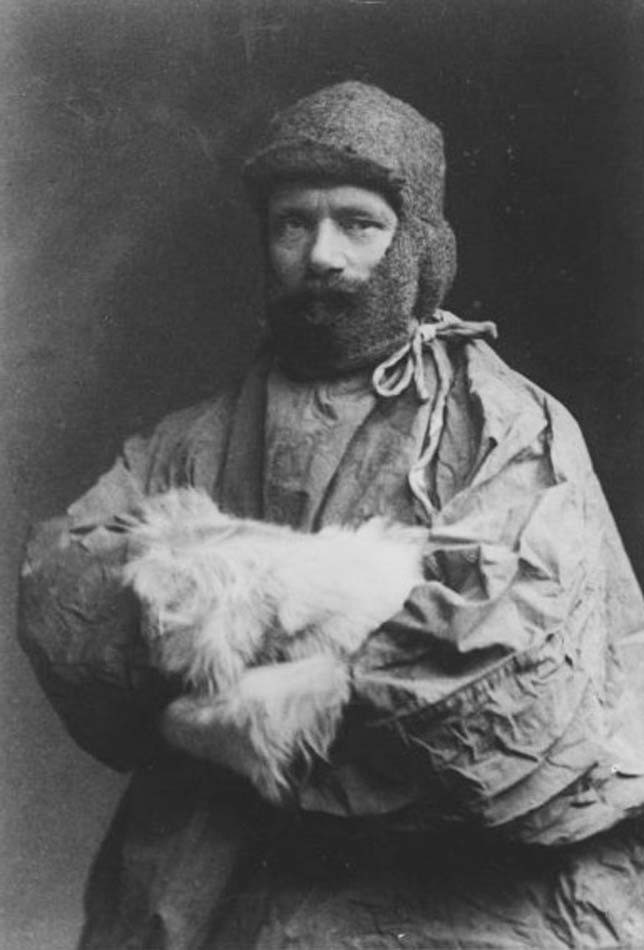
Frank Wild in polar gear, a posed studio shot prior
to Shackleton's Endurance expedition in 1914.
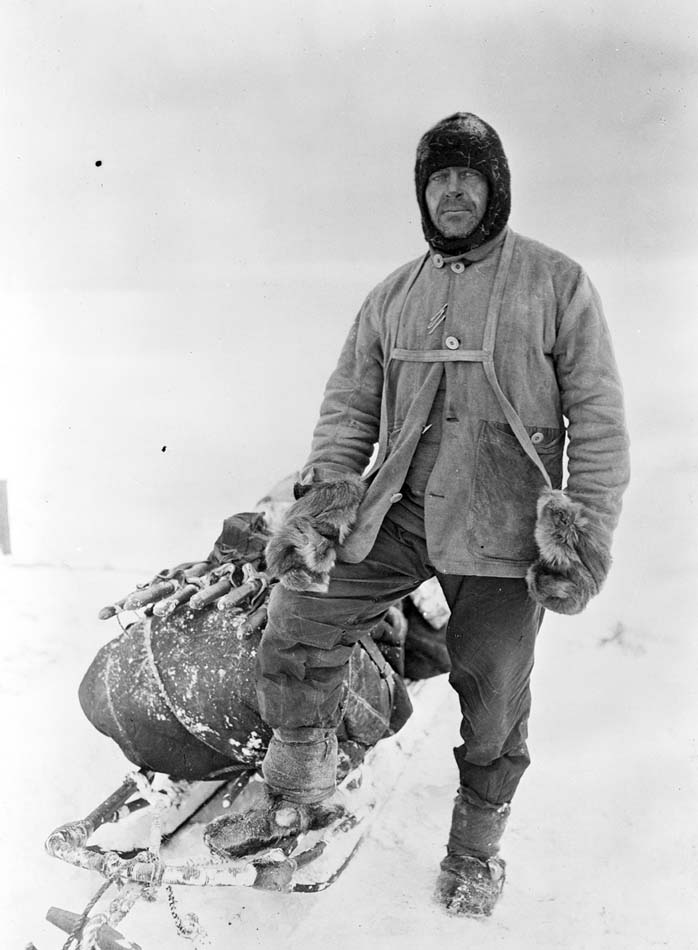
Captain Scott wearing manhauling clothing
with a sledge on the 13th of April 1911, the start of the expedition
which would see him and 4 others reach the South Pole but perish
on the way back.

A picture of the ship Gauss in winter quarters
1902, the ship of the relatively little known German expedition
of 1901-1903 led by Erich von Drygalski. This picture was taken
from a hydrogen filled reconnaissance balloon on March the 29th
1902 at a height of 490m (1600 feet), Drygalski was the first man
to fly in Antarctica. Note the long cone of wind blown snow behind
the ship.
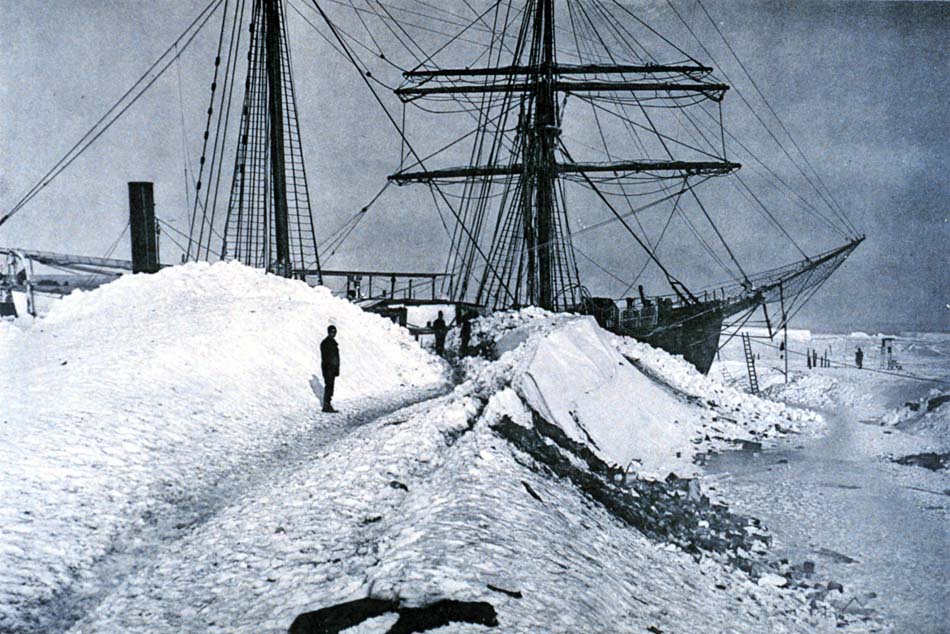
The Gauss in winter quarters 1902,
taking advantage of snowdrifts to get on and off the ship. The ship
was frozen into the ice 74 kilometres (46 miles) from the coast,
though the crew were able to sample the sea through holes cut in
the sea ice and visit the coast on sledging trips.
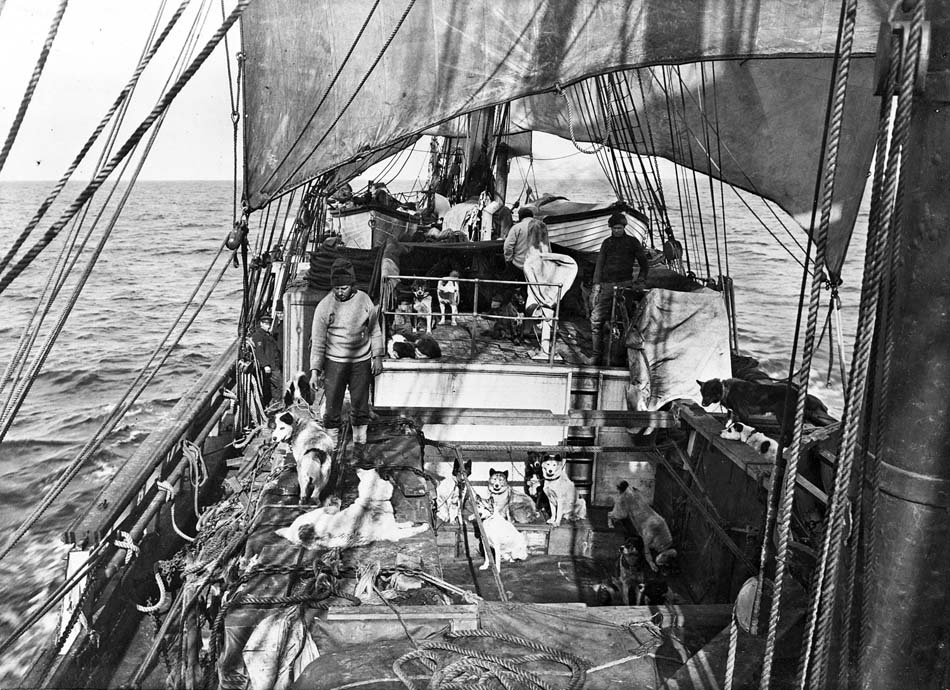
The deck of Scott's ship the Terra Nova
at sea showing where the dogs were kept, it also gives
a good indication of the small size of the ships of the Heroic Age,
this is a typical example.
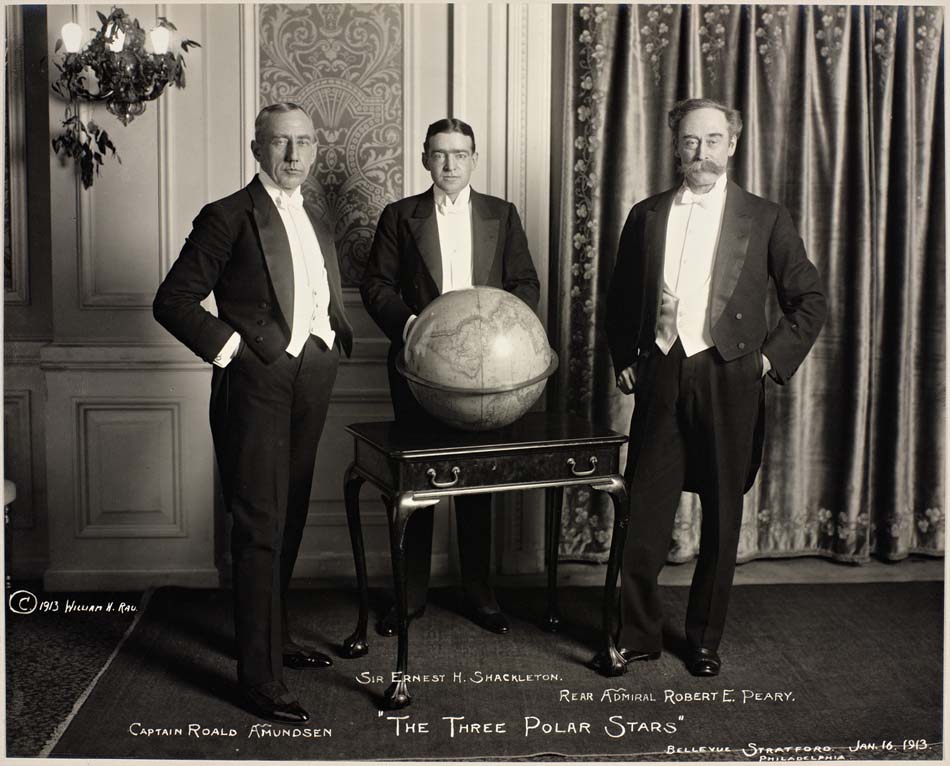
Three explorers and heroes of the Edwardian
Age taken in January 1913. Roald Amundsen after sucessfully
reaching the South Pole, Ernest Shackleton prior to the Endurance
expedition and Robert Peary who claimed to be the first man to reach
the North Pole, later shown to mot be true, but he probably came
within 60 miles (97 km).
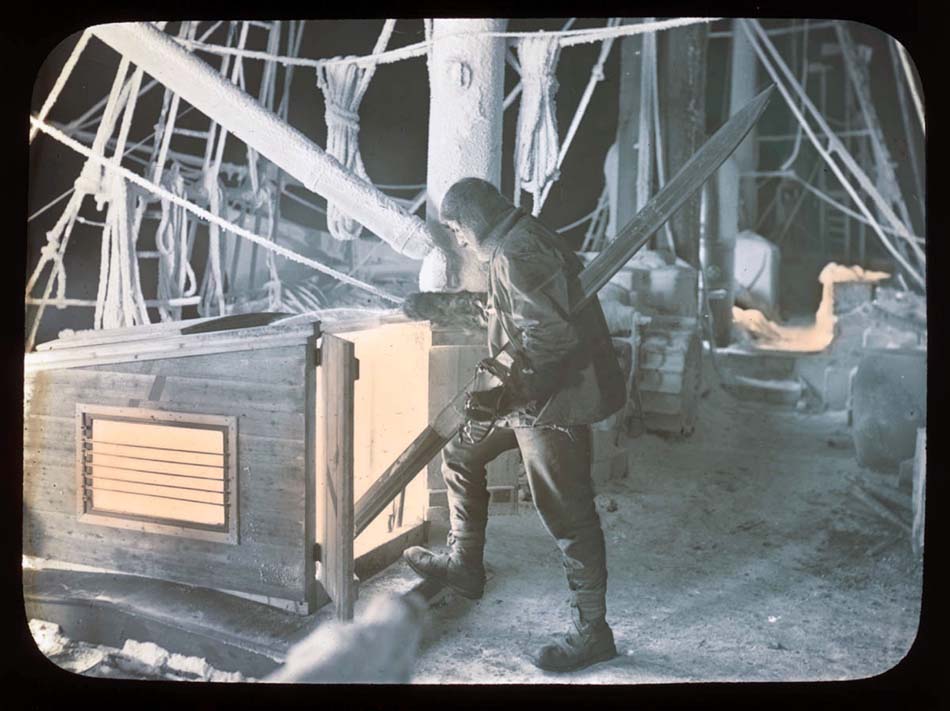
The nightwatchman returns after
having made his rounds of the ship and of the ice around the ship,
Endurance, 1915.
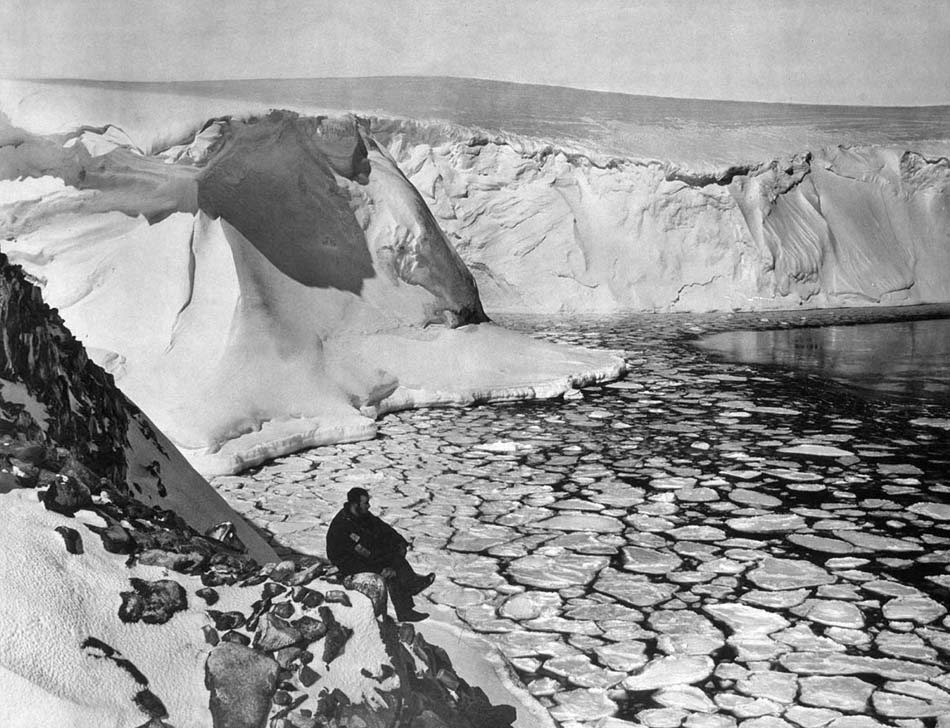
Frank Bickerton, on Mawson's Australian
Antarctic Expedition of 1911-1914 surveys pancake ice forming
in Commonwealth Bay
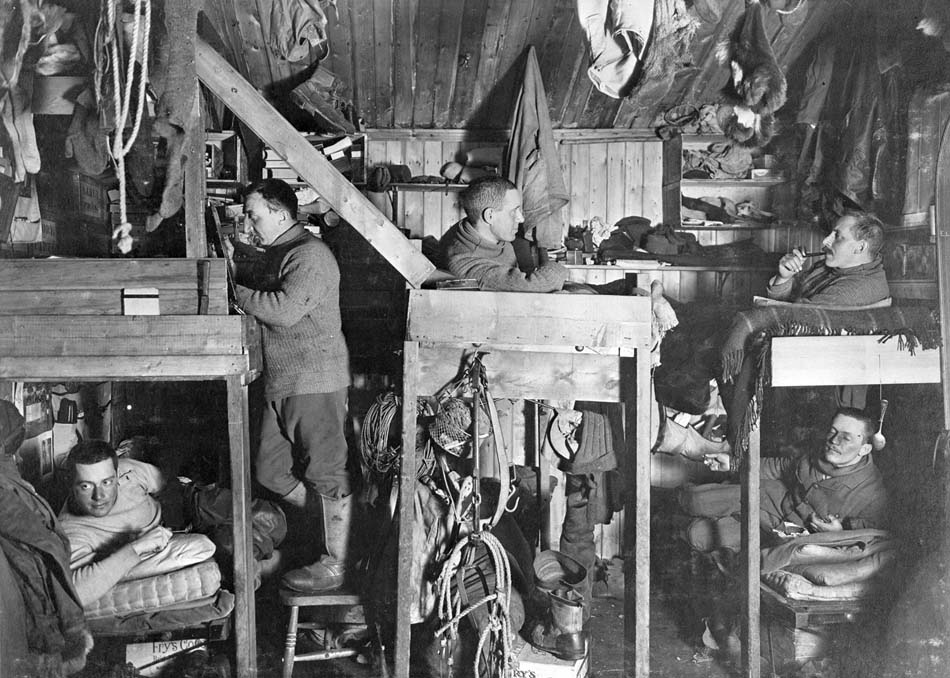
Scott's hut on the Terra Nova Expedition
at Cape Evans. These bunks were known as the "Tenements",
left to right : Apsley Cherry-Garrard, Henry Robertson Bowers, Lawrence
Oates, Cecil Meares and Edward L. Atkinson (lower).
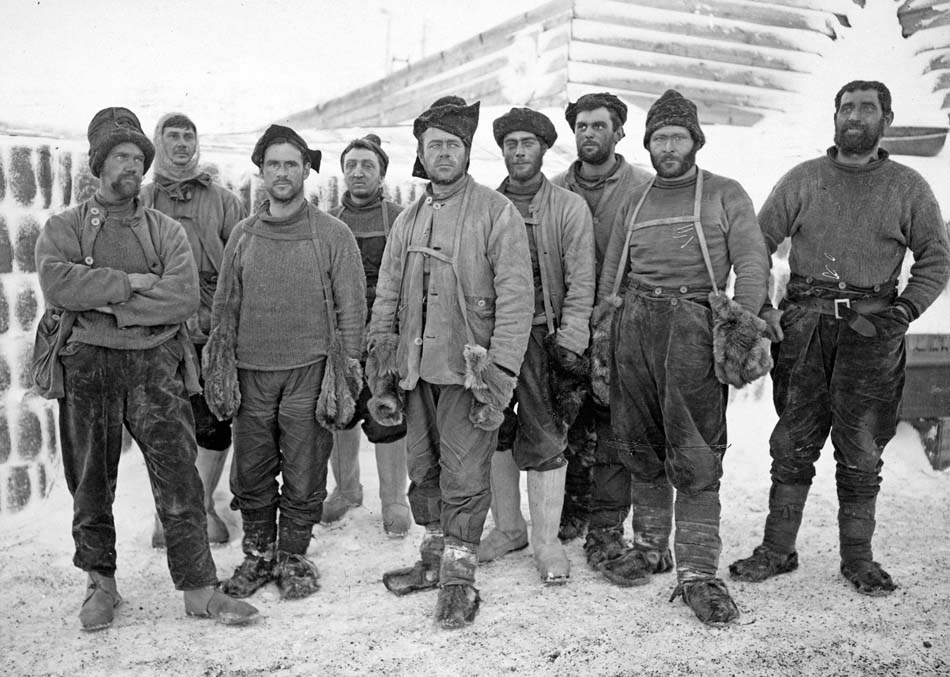
Captain Scott and the "depot laying"
party, the summer of 1910/11 was spent laying depots, stores
of food and fuel left on the ice to be used on the 800-mile journey
to and from the pole. Left to right: Taylor, Wright, Evans, Bowers,
Scott, Debenham, Gran, Evans and Crean.
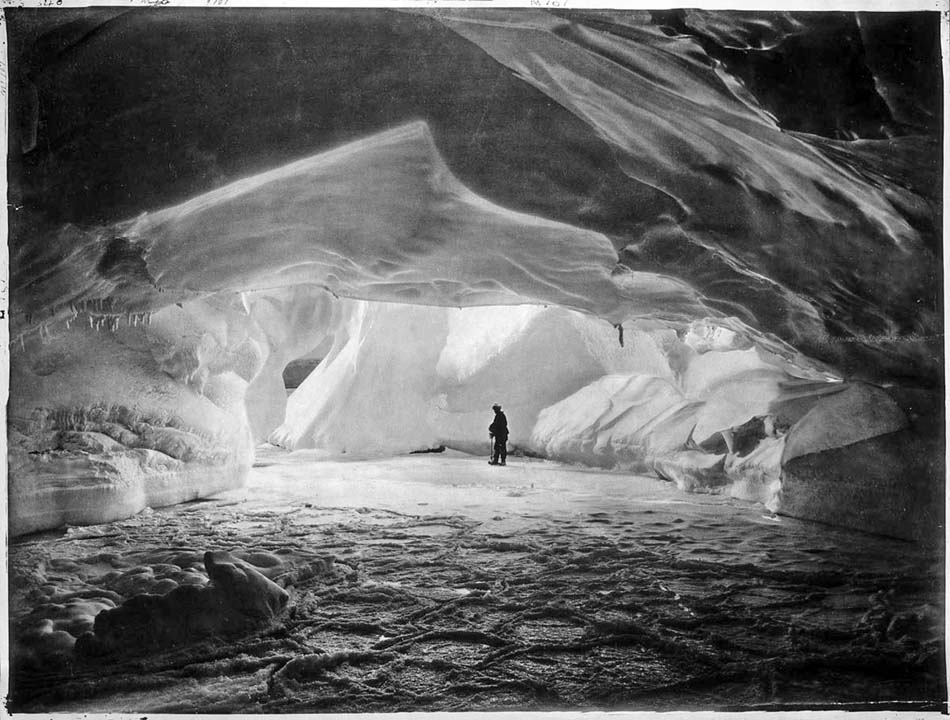
A cavern eroded by waves under coastal ice-cliffs,
the photographer is standing on the frozen sea, Adelie Land, Australasian
Antarctic Expedition, 1911-1914.

Captain Lawrence Oates with some of the ponies
taken to Antarctica by Scott on board the Terra Nova.
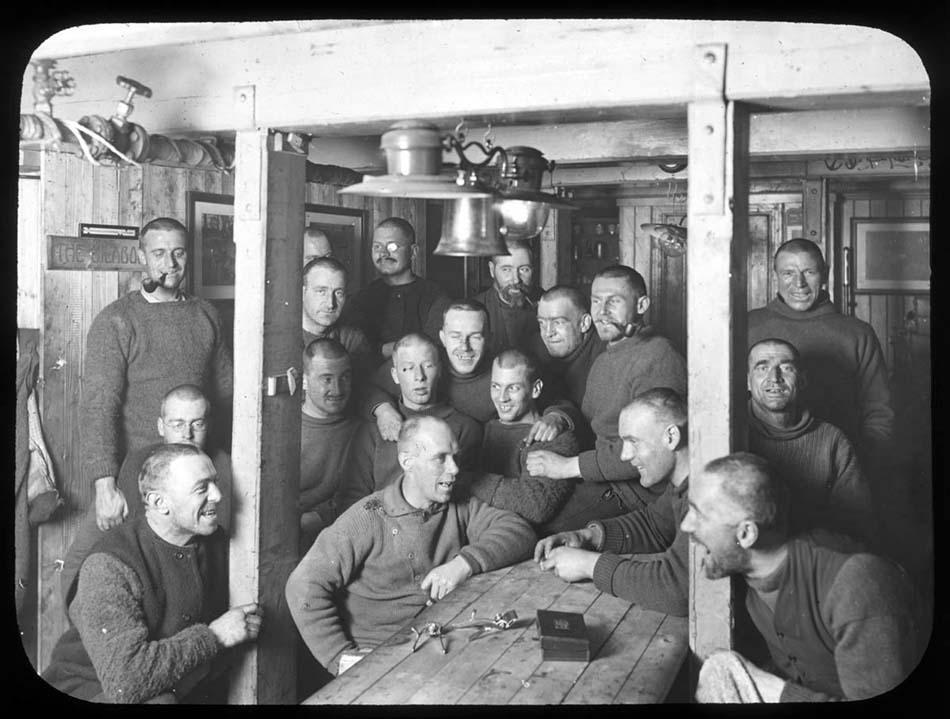
"We have had side-splitting fun this
evening. Everyone submitted to having their hair cropped
close with shears. Rickinson our chief engineer really has very
handsome dark wavy hair and was not at all anxious to have it cut
off, so in fun he told Sir Ernest that he would let him cut it if
Sir Ernest would afterwards permit him to cut his." Endurance
1915.
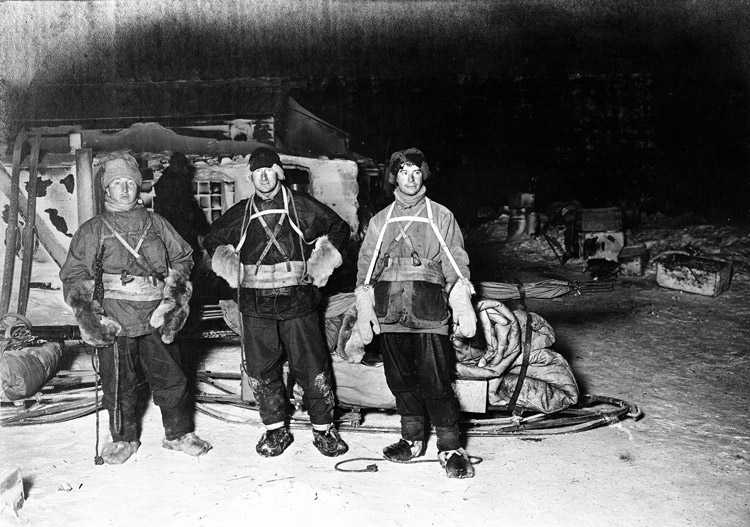
l to r: Bowers, Wilson and Cherry-Garrard
about to set off in the middle of winter to retrieve Emperor penguins
eggs, the journey would form the basis of Cherry-Garrards
book "The Worst Journey in the World".
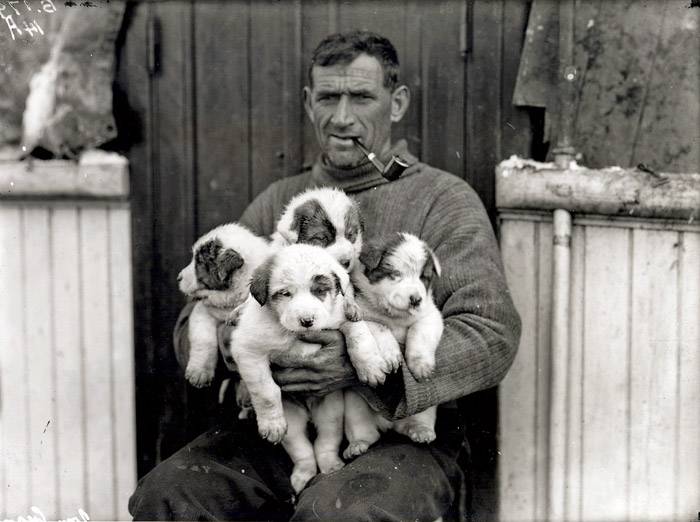
Tom Crean on board the Endurance
with some pups born to one of the sledge dogs during the journey
south.
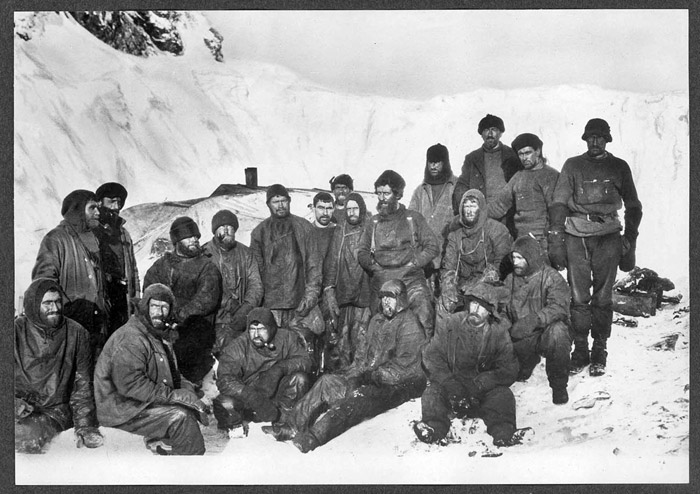
Endurance crew, picture taken on Elephant
Islands after 3 months, the men, tired, dirty, and hungry
were hoping for a rescue by Ernest Shackleton and 5 others who had
set off for help in a small boat, they would have to wait another
month.
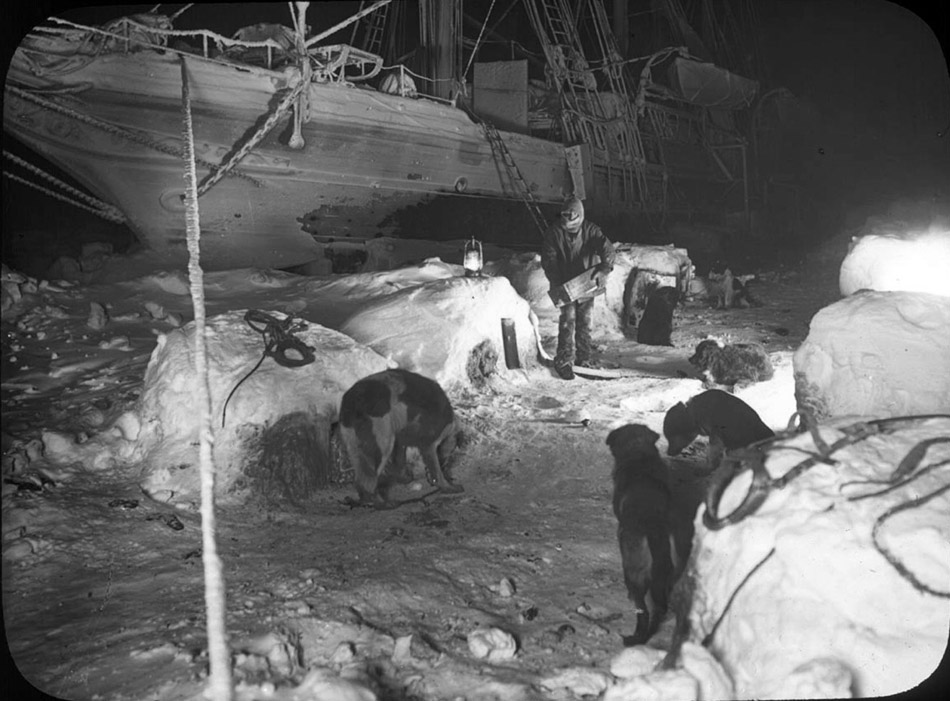
Feeding the dogs in the winter night,
the dogs were kept in "dogloos" on sea-ice beside
Endurance, kennels made of compacted snow and shaped like igloos
to give them shelter from the cold and wind.
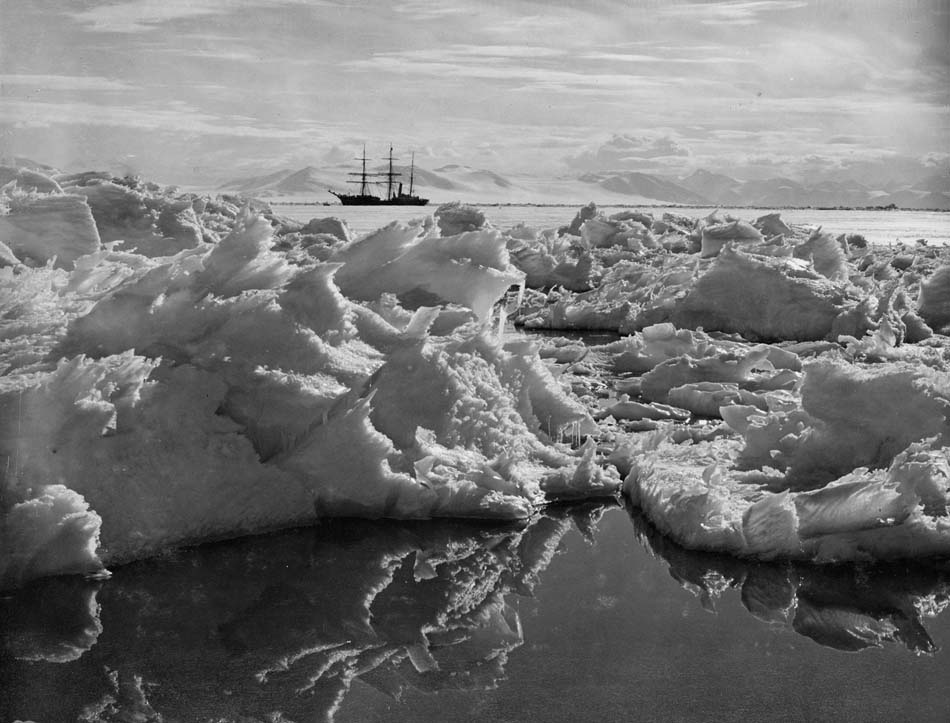
Captain Scott's ship, the Terra Nova
captured with loose pack ice in the foreground.
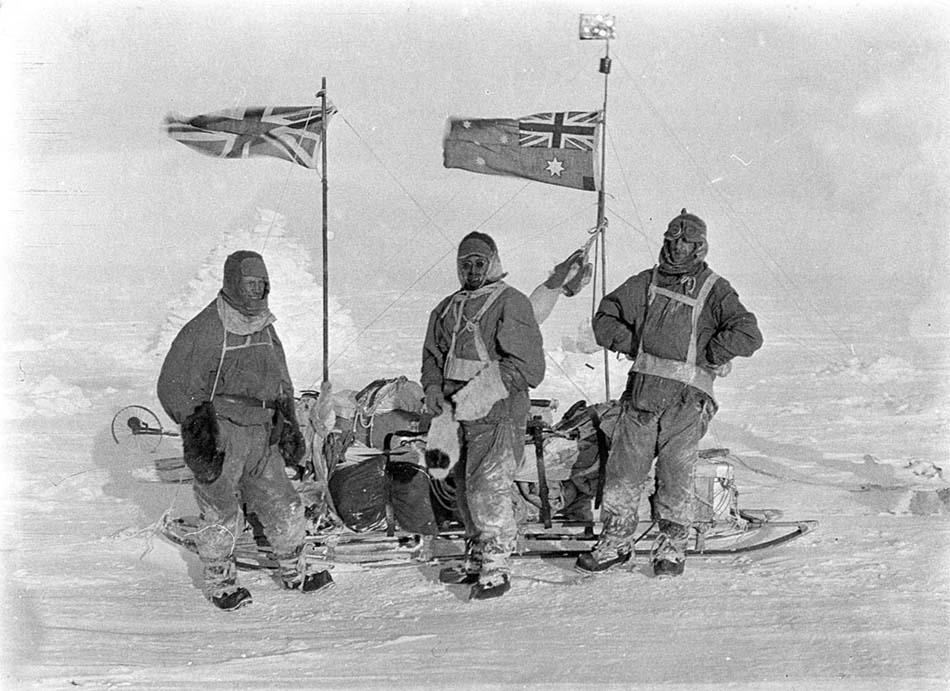
Hunter, Murphy and Laseron, Mawson's
expedition 1911-1914, this small sledging party were providing
depot-laying for another group, the tall cairn of snow behind them
is to indicate where food and fuel has been stored.

Driving a dog team across smooth and flat
sea ice, Mawson expedition. Amundsen gave Mawson his remaining
dogs at Hobart on his way back from Antarctica, so one or more of
these dogs may already have been to the South Pole and back.
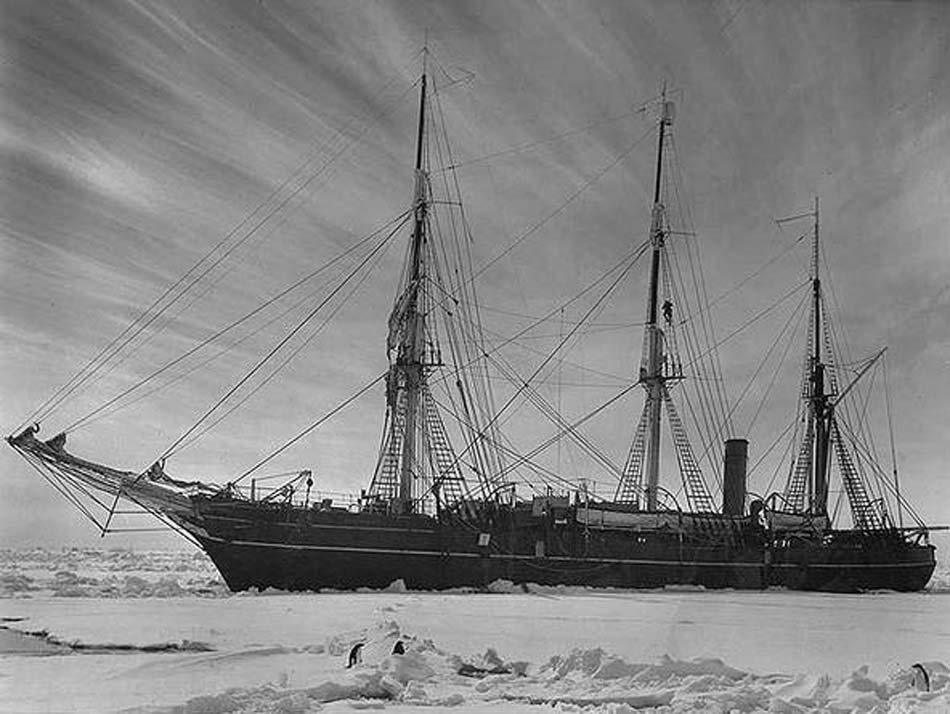
"Wind in the Sky", the Discovery
on Scott's first expedition in 1901-1904, moored at
the ice edge with the sky promising a gale at least.

Douglas Mawson on nightwatch in
the hut at Cape Royds, Shackleton's 1907-1909 Nimrod expedition.

Poleheim, Roald Amundsen's team of five
reach the South Pole for the first time on the 14th of December
1911. They left a tent with the Norwegian flag and a flag
of the Fram flying above it, inside was a message for Scott and
a letter for King Haakon of Norway.

19th January 1912, Scott's party reach
the pole to find Amundsen's tent already there. Scott
writes in his diary: "The worst has happened", "All
the day dreams must go".
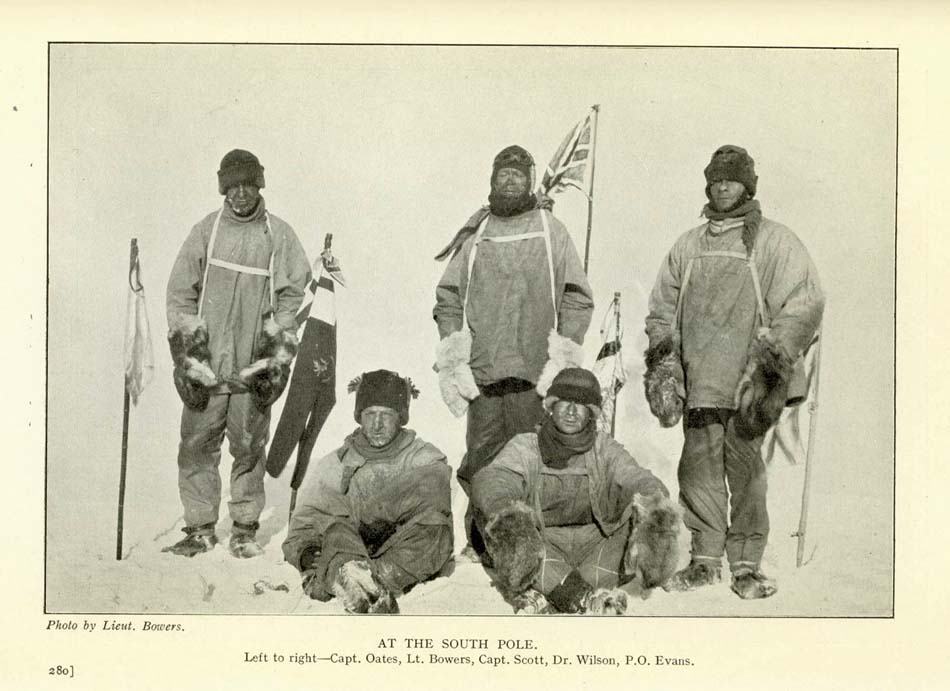
Scott's party at the South Pole, all
five men would die on the journey back by the 29th of March,
Scott's last diary entry. Their bodies in the tent where they
made their final camp were found 8 months later.
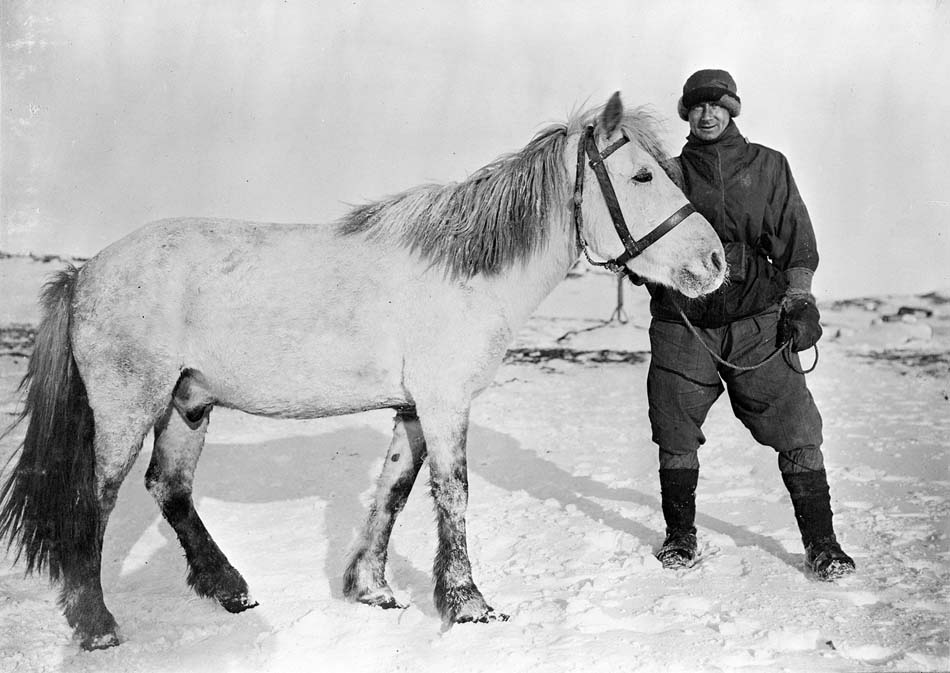
Edward Wilson with "Nobby" in October
1911, one of 20 Siberian ponies taken by Scott for his
South Pole attempt. The ponies fared badly, sinking deep into the
snow and were poorly equipped for the severe cold.
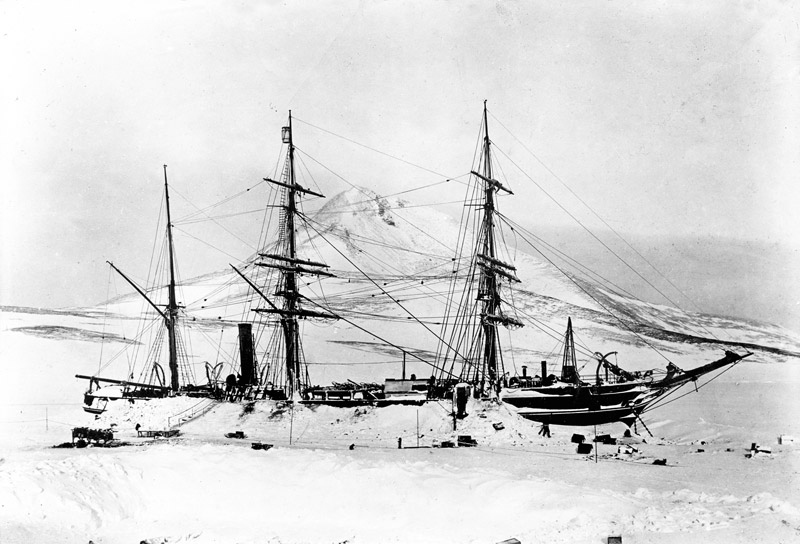
The Discovery frozen into the ice and used
as winter quarters. The intention was for her to be in
this position for the winter of 1902 only, she wasn't released
however and spent a second winter frozen in, she came very close
to being abandonded, but explosives, ice saws and luck meant she
was released on the 16th of February 1904.
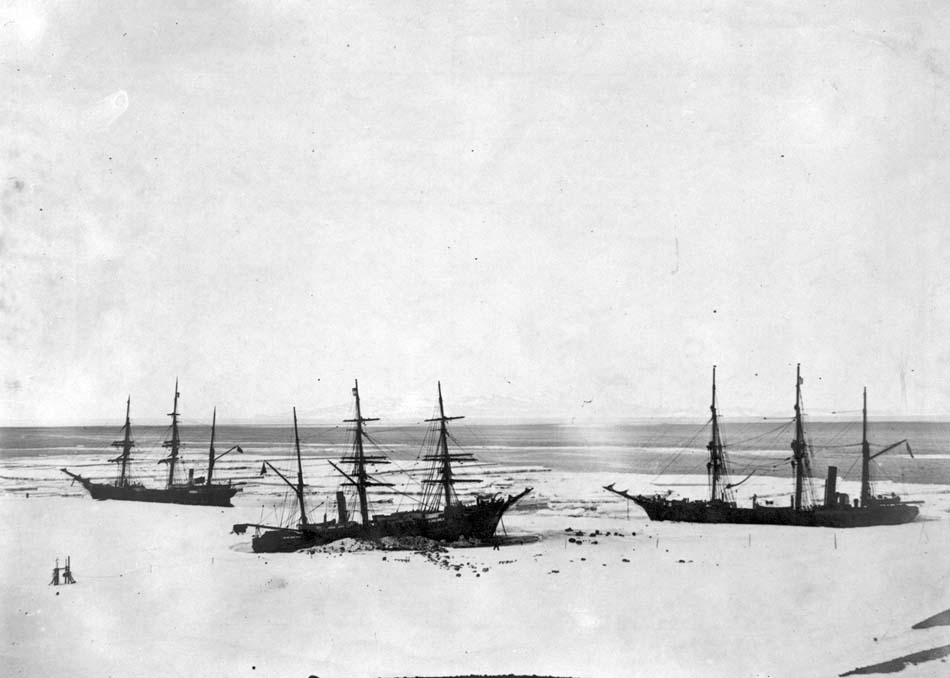
The relief ships Morning and Terra Nova having
fought through sea-ice to rescue Scott's expedition and the
ship Discovery (centre), expedition stores and equipment
had been loaded onto the relief ships in anticipation of having
to leave the Discovery behind.
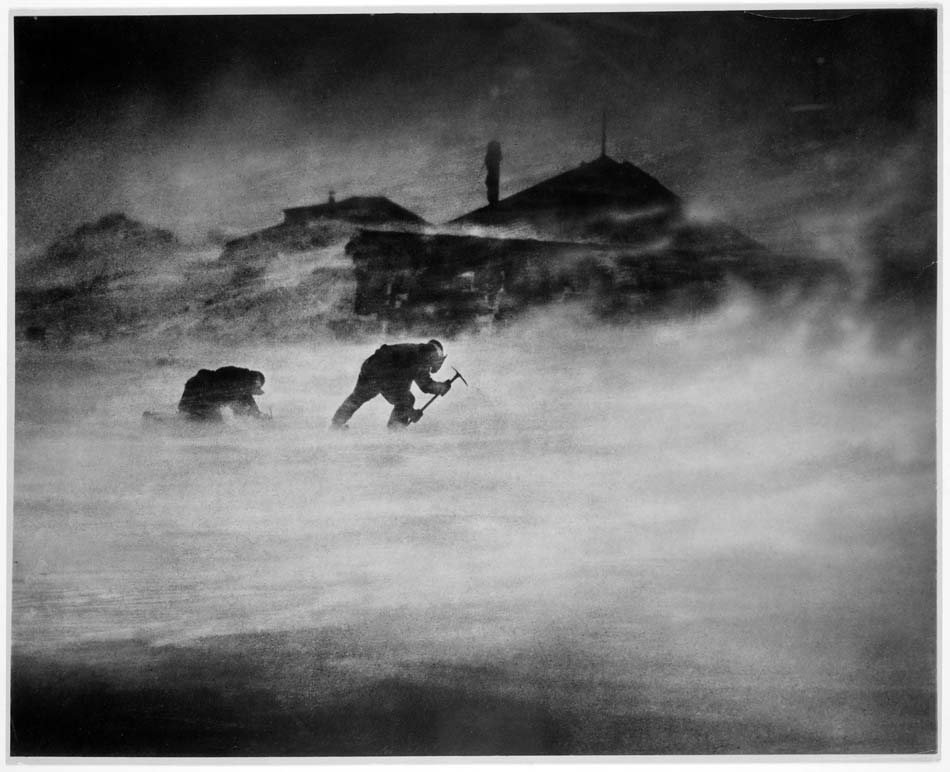
The Home of Blizzard, as Douglas
Mawson called his camp at Cape Denison in Commonwealth Bay. It turned
out that he had chosen one of the windiest places on earth to establish
a base, crampons and ice axes were often needed to move around outside,
and the men would often be blown across smooth ice before coming
to an unceremonious halt in a snow drift.

A sled dog called Chris is pictured listening
to a gramophone in 1911 with Scott's Terra Nova expedition.
It may have been an attempt to recreate the famous "His Masters
Voice" painting or as part of a sponsorship deal with the gramophone
company.
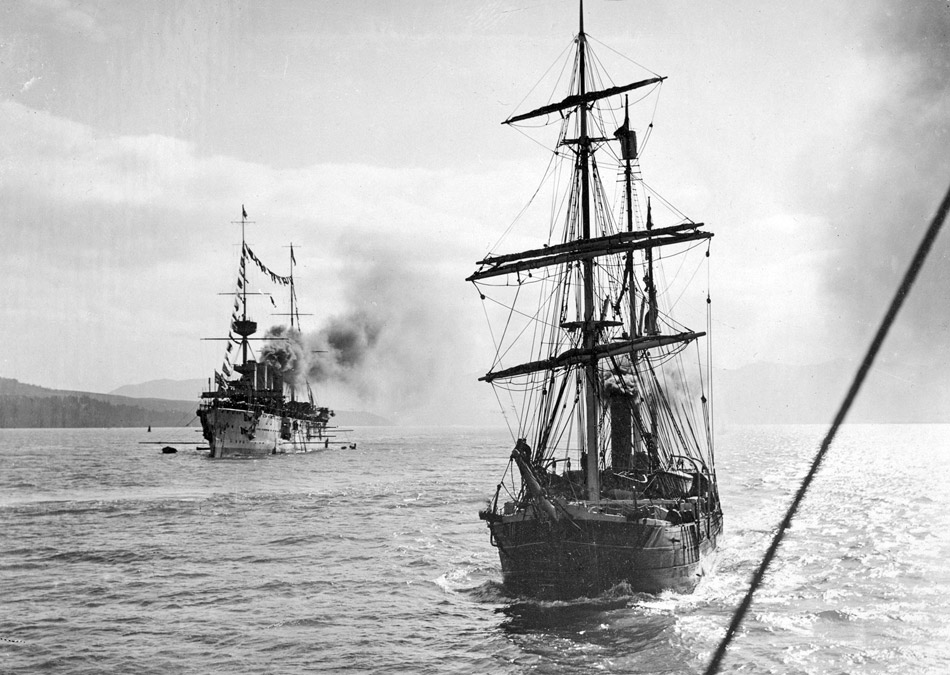
Nimrod (right) and H.M.S. Powerful (behind)
the flagship of the Australasian squadron, sailing in fraewell out
of Lyttleton Harbour New Zealand, 1st January 1908
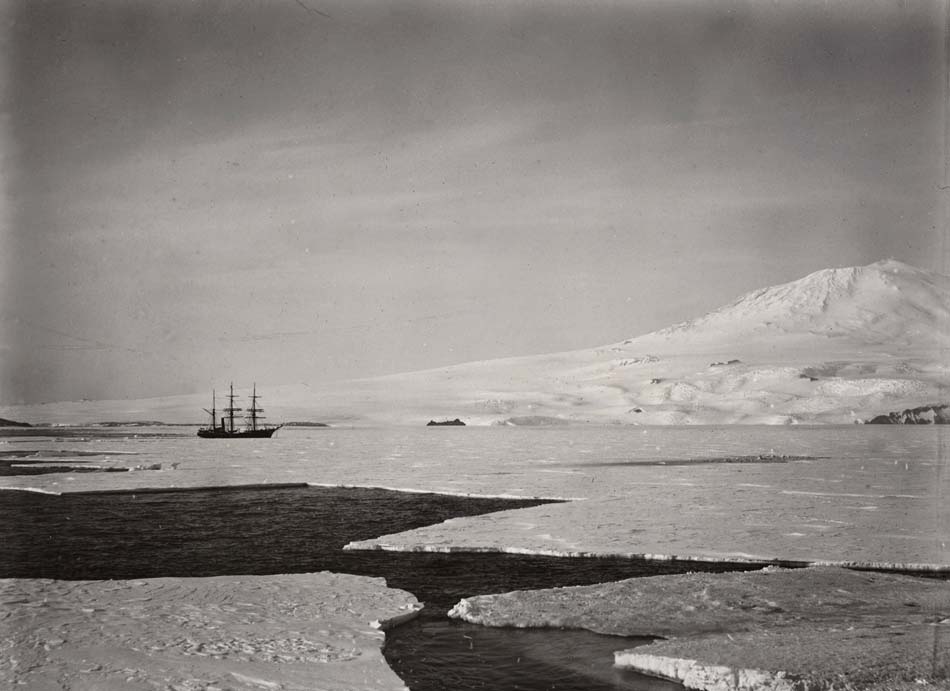
Discovery with Mount Erebus, shortly
after her arrival as the Discovery spent most of her time in Antractica
frozen into the ice. There is a timeless quality to this picture
as there are many others of others ships, aircraft or vehicles with
Mount Erebus as a backdrop, in 1840, it would have been H.M.S Erebus
and H.M.S. Terror with Captain Cook.
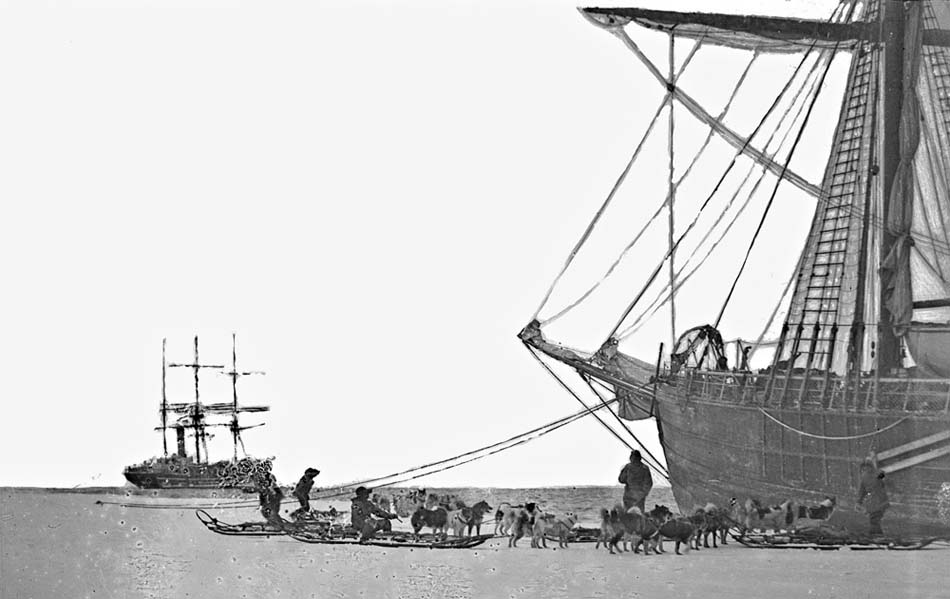
A meeting of Scott's ship, the Terra
Nova, in the background with Amundsen's ship the Fram
in the Bay of Whales in Februray 1911, Amundsen was present, but
Scott was at the base in McMurdo Sound.
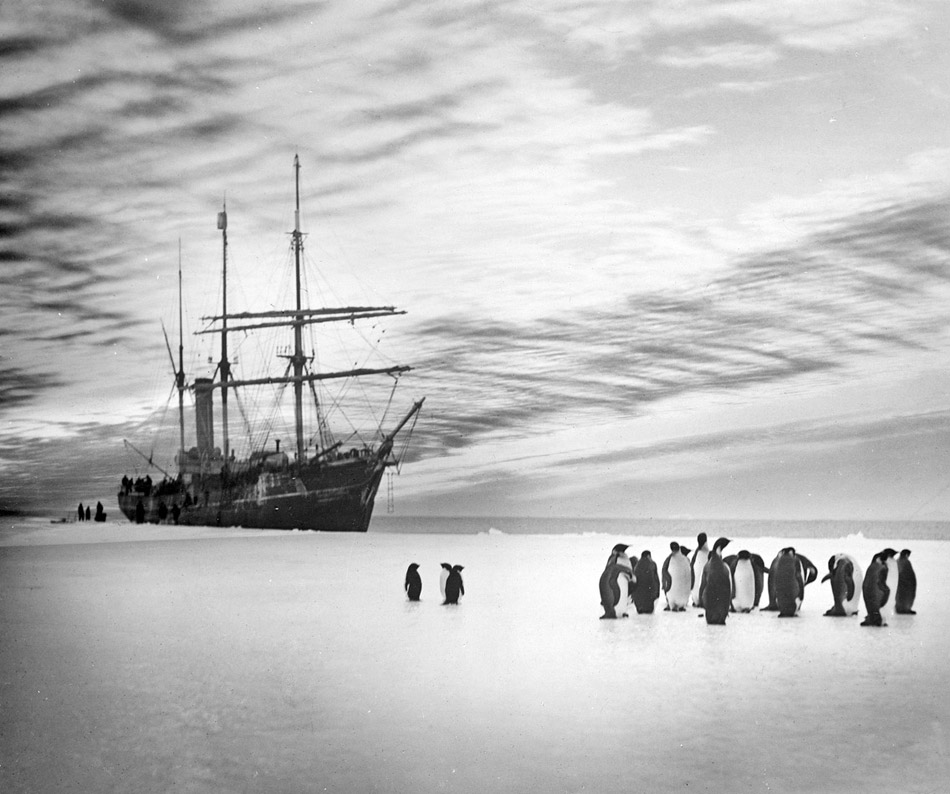
Mawson's ship, the Aurora anchored
off the edge of the ice floe at Mawson's second and western
base along with a customs party of Adelie (smaller) and Emperor
(larger) penguins.
